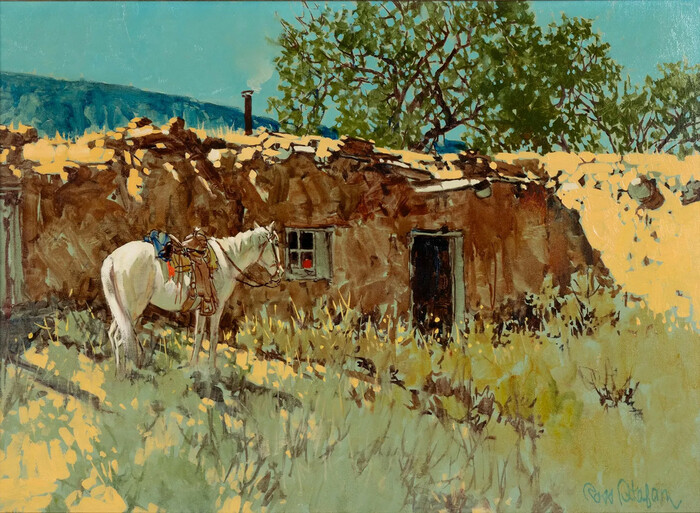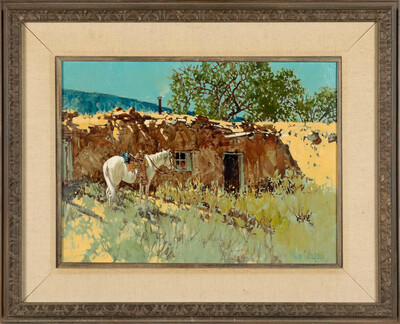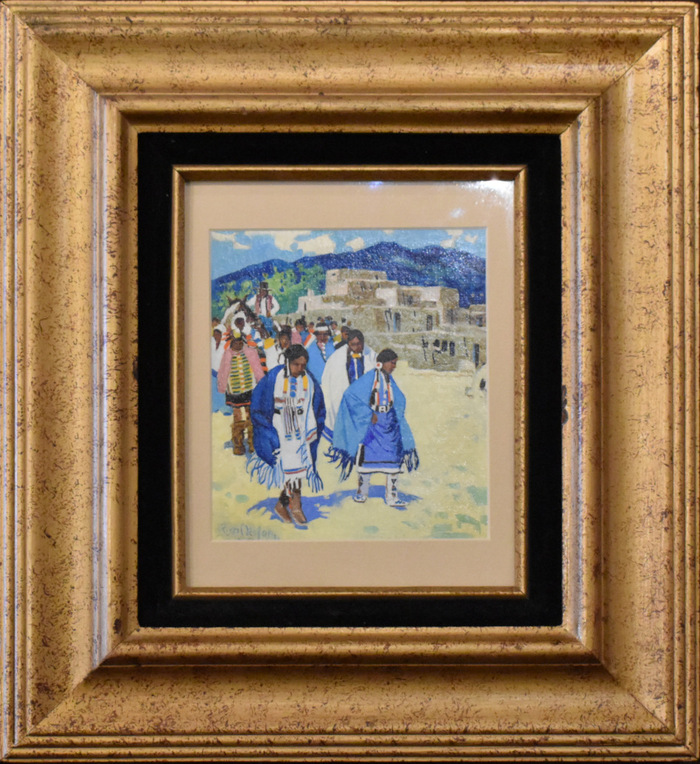Ross Stefan "South of Taos, New Mexico. Rio Grande Rancho, Lupe's White Horse"
-
- Ross Stefan
- (1934-1999)
- Arizona / Wisconsin Artist
- Image Size: 16 x 22
- Frame Size: 25 x 31
- Medium: Oil
- "South of Taos, New Mexico. Rio Grande Rancho, Lupe's White Horse"
- Contact for Price & Info
- View All By This Artist
Details
Cowboys, Horse, Western, Old West painting
-
-
Biography
Ross Stefan (1934-1999)
Born in Milwaukee, Wisconsin, Ross Stefan became a painter of western scenes in traditional style. His subjects are Southwestern desert and mountain landscapes and stereotypical figures of that part of the country.
He had his first one-man show at age 13 and then living in Wisconsin, was much influenced by a studio visit to Dan Muller, an illustrator.
In 1953, when he was a teenager, he moved to Tucson, Arizona with his family, and his father worked in advertising, which furthered Stefan's interest in illustration art. He studied art and philosophy at the University of Arizona and did part-time sketching for the Tucson newspaper.
Norman Rockwell was one of his early heroes. Encouraged by Ivan Rosequist, pioneer Arizona art dealer in Tucson, Stefan quit his unproductive activities in the University of Arizona art department and set out on his own as a fine artist.
Source:
Peggy and Harold Samuels, "The Illustrated Biographical Encyclopedia of Artists of the American West"Ross Stefan was born in 1934 in Milwaukee, Wisconsin. His father, who worked in advertising, introduced him to art at a young age, and young Ross Stefan had his first one-man show at the age of 13. His first (and perhaps only) major influence was the noted Wisconsin illustrator Dan Muller, a visit to whose studio marked a major developmental turning point in his career.
Due to ill health, Ross Stefan moved to southern Arizona in 1953, where he became an art student at the University of Arizona. In his spare time, Stefan worked as an illustrator for the Tucson Daily Citizen, using a melding of his own self-taught style with that of his early muse, Norman Rockwell. This foray into paid work convinced Ross Stefan to quit his studies at the University and begin painting full-time in 1955 in a studio and gallery he established in Tubac. It was also in 1955 that Ross Stefan first traveled out into the desert to spend time with
Fame came to Ross Stefan in 1971, when his one-man show in New York City virtually sold out on opening night. From that point onward, Stefan's work was amongst the most coveted and best collected in the state of Arizona, with major retrospectives of his work at the Phippen Museum, the Harmsen Collection, the Denver Art Museum, the Pierce Western Collection, the Phoenix Art Museum and the Sangre de Cristo Arts Center.
Ross Stefan's work is often described as "Southwestern Impressionist", a reduction that takes into account his broad strokes and heightened color palette without considering the proportional accuracy and spatial realism of his landscapes, figures and architectural depictions. Ross Stefan's scenes of pueblo life and the southern Arizona landscape are still archetypes of the genre, and his legacy is secure as one of the leading Arizona artists of the twentieth century.Born on June 13, 1934 in Milwaukee, Wisconsin, Ross Stefan developed a love for the arts at an early age. His father, who worked in advertising, provided Stefan with just the right amount of art to wet his lips. By the age of 13 Stefan debuted his first one-man show. Soon after, because of a health, he moved to southern Arizona.
Engulfed in the love for the western atmosphere, Stefan began sketching landscapes. He has been called a self-taught artist, but got encouragement from the Wisconsin Illustrator, Dan Muller on several visits.
Stefan became an art student at the University of Arizona. During his education he did part time sketching for the Tuscan Newspaper. He thrived on the works of his early muse, Norman Rockwell, as an inspiration in technique. It is rumored that Ivan Rosequist of the Rosequist Gallery in Tucson was the encouragement that Stefan needed to blossom as an artist to his fullest potential.
Whether or not Rosequist was that influence, by 1955 Ross Stefan took the leap, and began painting full time with a studio and gallery in Tubac, Arizona. That same year, Stefan stayed with the Navajos, using the land and the people as his ongoing trademark.
His paintings became a sensation. In 1971, his New York One-Man Show consisting of 16 oils of Southwestern landscapes and figures, proved to be quite successful with a virtual sell-out the first night. By his brush strokes, which are airy and wide, he has gained the reputation as an impressionist artist. His painting demonstrates the development of color, which has been called the highlight of impressionist art.





